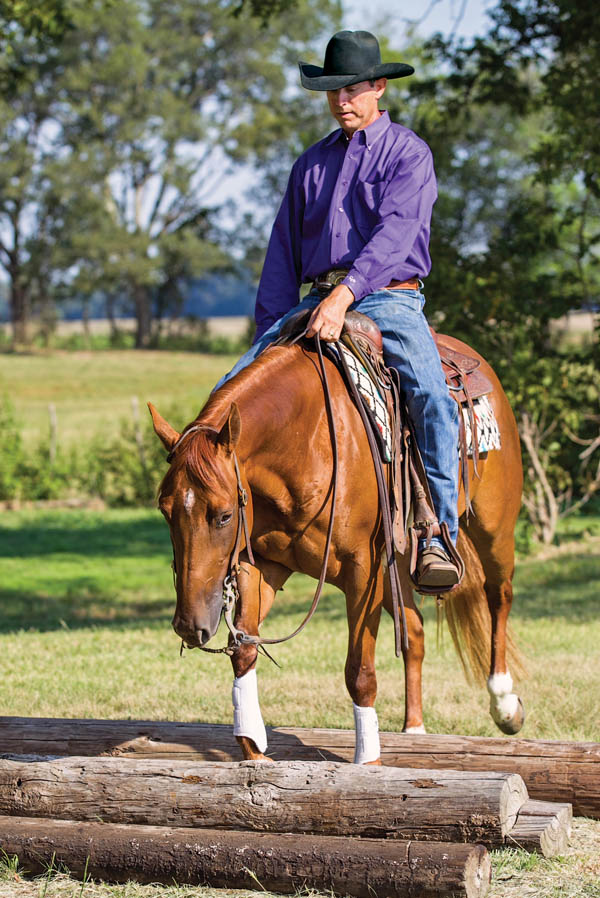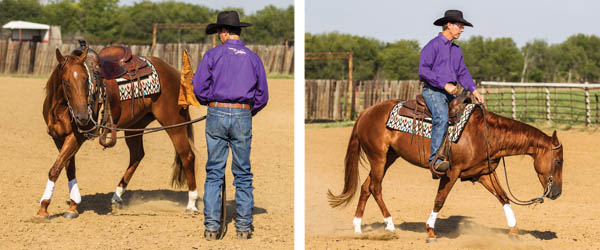During my time in the horse industry, I’ve seen riders struggle with a variety of issues while working with their horses. Some are due to problems in the horse, but others are pilot error. It can be frustrating for riders to work hard to achieve their goals and run up against walls over and over.
[READ: 6 Horse Training Myths]

I’m going to talk about six mistakes I see riders make as they work with their horses. It happens at all levels, with horses in many disciplines. I’ve even been guilty of some such mistakes myself. I’ve seen the negative results, so I want to show you why certain habits aren’t helpful. I’ll share suggestions of how you can break these habits and replace them with productive routines that’ll help you and your horse progress with your objectives.
Not Enough Groundwork
The No. 1 mistake I see is lack of adequate groundwork. At the beginning of working with a horse, when the horse and rider are still learning together, it seems as though riders will do some groundwork and some ground exercises. But once they start riding more, they tend to get away from that part of training.
I do some form of groundwork daily before I ride. Depending on the day or the horse, it could last just five minutes or be 15 minutes on the ground before I ever step into the saddle. I run through a checklist that gets rid of the horse’s excess energy and gives me the tools I’m going to need before I get on him.
For instance, I’ll put the bridle on and hold onto the end of the reins, pushing him about 3 feet out away from me. I’ll work on getting his face soft, and on getting the body working right and yielding to pressure. I’ll use my hand or a training stick to aid in body yielding. I want to get the horse softened up, turning, and backing up without resistance.
By doing so, I don’t have to go through what seems to be a common thing for some riders: a really bad first 15 or 20 minutes of riding before the horse starts working decently. Horses can get into a bad habit of just being kind of silly and not being focused when you first get on. You can eliminate that possibility with daily pre-ride groundwork.
[READ ABOUT: Ground Work]
Too Much Leeway
Another frequent rider error, especially in the beginning stages of training, is that of giving the horse too much room for mistakes. Whether it’s throwing rein slack at a horse that’s only been ridden 10 times and hoping he doesn’t run off, or loping in a huge arena with fingers crossed that he’ll slow down on his own, you can get in trouble that way.

My rule of thumb: Never ask a question of a horse when you don’t know what the answer will be. When you ask your horse to do something or attempt to teach him something new, make sure that you know the desired response. Start with close contact and don’t give your horse a lot of room at first. This gives you the opportunity to correct him right away if he makes the wrong choice, and also gives him the chance to succeed. Don’t give him so much room, whether in rein length or arena size, that he’s likely to fail.
Throwing “Whoa” Around
The word “whoa” means “stop,” and is a cue that must be taught. Too often, I see riders who use the verbal cue on horses that don’t have a clue what it means. Typically, the rider hauls back on the reins because he thinks the response should have been automatic; as a result, the horse can get a negative association with the word. He hears it, and suddenly the rider starts pulling and picking at him for a reason he doesn’t understand.
If this is your situation, you want to work on what I call manual and automatic transitions. Think in terms of manual and automatic transmissions on a car or truck.
Make sure that manual works first, meaning your horse understands the obvious cues before relying only on subtle cues. For stopping, “manual” means that you begin by pulling on the reins to stop. You do this again and again. When the horse has the manual cue down, then you start working on the cue association that leads to “automatic.” “Whoa” without rein contact is the very last piece, not the first.
On that note, “whoa” doesn’t mean slow down. It doesn’t mean quit prancing. It means halt. Use it only when you want the horse to stop. Once your horse understands the verbal cue and it’s used correctly, the word “whoa” is actually a reward because he gets to stop working. By all means, it’s a command and it’s not to be ignored, which is why we only add it later when the horse already knows how to stop. You don’t ever want your horse to ignore that word once you start to use it.
Steering Just the Face
When you want to direct a horse, it’s a mistake to guide only its head with the reins. Instead, you want to steer what’s under the saddle horn—the feet—by guiding from the outside to the inside with outside leg and rein. For example, if I want to steer to the right, I use my left leg and rein to push my horse the direction I want to go. I use my inside rein to teach him shape and position, but it’s the outside rein and leg that establish direction.

The nose is the hood ornament, not the steering wheel. A horse can still keep going forward, without turning, even after you’ve pulled the inside rein clear around to your knee. That’s why you need to visualize the front feet beneath the horn as the steering mechanism and the back feet as the brake and the motor. If the saddle horn is pointed east and you want to go north, you need to push the front feet in that direction. When you can change the direction in which the saddle horn is pointing, you can change the direction of the horse.
[READ: Stop Bugging Your Horse]
Inconsistent Riding Schedule
Here’s another common error. Someone buys a nice, finished horse. The horse has been in a training program with a routine, much like a university student who goes to class every day and does his studies. The student might get the weekends off or an occasional holiday, but it’s only a day or two off at a time.
The new owner thinks the horse will be fine with just one or two rides a week, often because that’s as much time as the rider has free to devote. It might go well for a while, but eventually the horse is going to get out of performing at its best. It’s like summer vacation to kids in school—the horse ends up losing discipline.
Horses need that discipline, whether it’s groundwork or something small. Try to be as consistent as you can. I know we all have work and situations where we can’t get out there every day. I do, too. I’m often away doing clinics. But as much as possible, your horse needs to get that daily lesson, just like he’s in school. When he’s in that groove, things will go so much better. Your horse will be focused, in learning mode, and in training.
Taking purposeful time off is different than what I’m talking about here. In my program, there are times when we’ll turn horses out and leave them alone for a month or so—sometimes even longer. But once they’re back to being ridden, they’re back in school.
Whether your school is three days a week, or five or six, or even two days a week, make sure your horse knows he’s in school by making sure he learns something that day. One thing I’ve learned over all these years: If you aren’t teaching the horse the right thing, he’s learning the wrong thing. That’s just how it works.
[READ: Making Time to Ride]
Overtraining on One Discipline
This mistake isn’t quite as common as the others, but still happens. It occurs when someone gets a horse that’s trained in a specific discipline, and that one discipline is all the rider works on with the horse. Horses get stale doing that. Oddly enough, you’ll maximize your specialty if you do some cross training.

Cross training is finding other things for the horse to do. I go on trail rides with my reiners. I work cattle with them, teach them ground games and obstacle work, and all kinds of other skills. I ride each horse five or six days a week, but only work on his main discipline for a couple of those days. I’ve found that horses progress so much faster this way, and that we get along better as well. For example, if the horse is off his confidence for sliding stops, I’ll go hit the obstacle course and help him get his confidence back before working on stops again. It makes a tremendous difference.
[READ: Expanding Riding Events]
Craig Johnson, Gainesville, Texas, is a National Reining Horse Association $1 Million Dollar Rider, a two-time NRHA Futurity champion, an NRHA Derby champion, a 14-time world champion, and an international reining gold medalist. His specialties are reining, Western dressage, and ranch riding.






